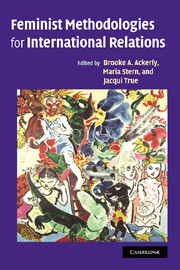Book contents
- Frontmatter
- Contents
- Notes on the contributors
- Acknowledgments
- 1 Feminist methodologies for International Relations
- Part I Methodological conversations between feminist and non-feminist IR
- Part II Methods for feminist International Relations
- Part III Methodologies for feminist International Relations
- 10 Bringing art/museums to feminist International Relations
- 11 Methods of feminist normative theory: a political ethic of care for International Relations
- 12 Studying the struggles and wishes of the age: feminist theoretical methodology and feminist theoretical methods
- Conclusion
- Bibliography
- Index
10 - Bringing art/museums to feminist International Relations
Published online by Cambridge University Press: 12 January 2010
- Frontmatter
- Contents
- Notes on the contributors
- Acknowledgments
- 1 Feminist methodologies for International Relations
- Part I Methodological conversations between feminist and non-feminist IR
- Part II Methods for feminist International Relations
- Part III Methodologies for feminist International Relations
- 10 Bringing art/museums to feminist International Relations
- 11 Methods of feminist normative theory: a political ethic of care for International Relations
- 12 Studying the struggles and wishes of the age: feminist theoretical methodology and feminist theoretical methods
- Conclusion
- Bibliography
- Index
Summary
It is commonplace for theorists, practitioners, and observers of international politics to speak about the art of politics, the art of diplomacy, even the art of war. A terrorist bombing is said to produce “surreal” effects, Surrealism having been a prominent school of visual and literary arts in the interwar years. This or that election is called a “farce,” as though referring to a light dramatic work in which highly improbable plot situations, exaggerated characters, and often slapstick elements feature. UN Security Council members “dance” around each other on the issue of war with Iraq. There are “dramas” in the Pacific as asylum seekers are shunted from one would-be haven to another.
Fine-arts references to international relations are meant to be gestural and expressive. They do not signal a formal relationship between visual, literary, and performing arts and such phenomena as terrorism, war, elections, immigration, or politics in general. Yet the throwaway metaphors should tell us that there is art (hidden) within international relations – or at least there is the suspicion that the typical methodologies employed by the field of International Relations (IR) are not creative and imaginative enough to grasp the world it studies. Missing from IR (discouraged, in fact) and present in art is the non-rational realm of bodily sense. We may read an IR piece and think the author shows a “feel” for the topic, that he sees the issues well – but always within the confines of rational analysis, as demonstrated by a clear problem statement, robust evidence, interpretive consistency, and logical argumentation.
- Type
- Chapter
- Information
- Feminist Methodologies for International Relations , pp. 201 - 220Publisher: Cambridge University PressPrint publication year: 2006
- 7
- Cited by



